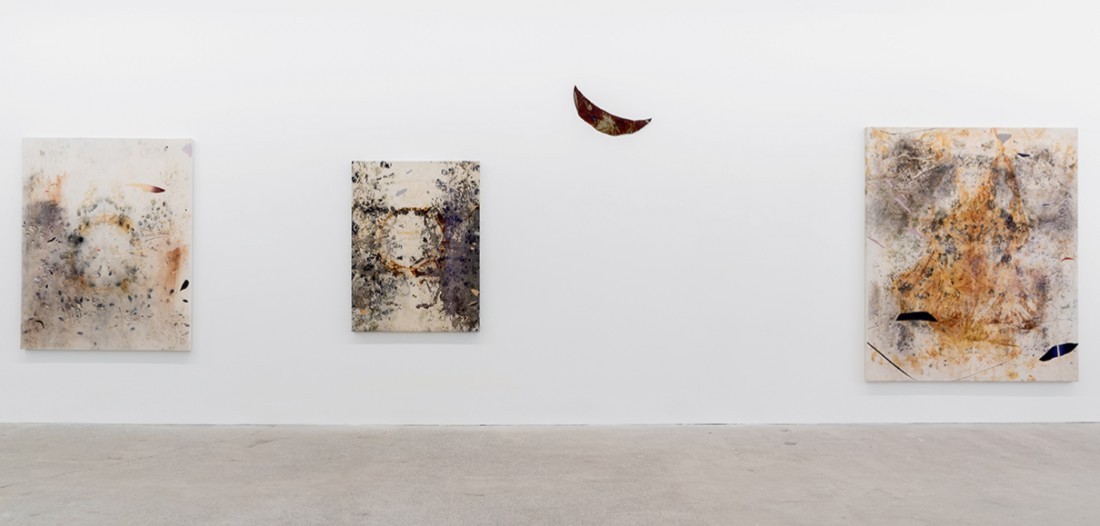Gillian King
Spring might be on its way. The earth is fertile, softening, opening up to make way for a languid and lush rebirth. Our feet sink in slightly as we walk across the lawn—muck and mud being pierced tentatively by small green tendrils of grass. Dampness and rot give way to the faintest hint of dew-kissed blossoms, ferns unfurling and squishy worms making their ascent into the sun. So eager are we for this moment, it is tempting to stick our hands right down into the ground, to squat down into it, roll around in the dirt. To feel as alive as, and enlivened by, the earth.

Gillian King, Moon Marrow, 2019, cold wax medium, oil, raw pigments, rust sediments, thread, and various plant materials (including onion skins, roses, rust sediments, sumac and wildflowers) on canvas, 48 x 36 inches. All photos: Jean-Michael Seminaro. All images courtesy Galerie Nicolas Robert.
Gillian King’s exhibition “Sediment” at Galerie Nicolas Robert comes at exactly this moment. Here, the stark white walls and grey concrete floors are eased into the season, thanks to the eight telluric canvases that hang evenly throughout the space. These large-scale works are the latest in King’s production—one that is concerned, both on material and philosophical levels, with the relationship among painting, the earth and the body. Their muted palettes of ash and lilac, rust and blush, ochre and sage are derived from dyes and pigments that the artist makes herself, coaxing them out of locally sourced plants such as sumac berries and black walnut, cooking scraps of red and yellow onion, discarded rose petals, and fresh-picked wildflowers, using traditional methods better known in the textile and quilt making trades. Dousing each tawny canvas in a mineral salt solution before their dying causes the colours to adhere in abstracted, unexpected ways, since the natural chemical reactions between each plant are not entirely predictable. After sowing each tinted garden, King also introduces the corrosive process, directly printing geometric shapes with found-metal bands and scraps soaked in a vinegar brine. Once they are dried, stretched and set, King incorporates gestural responses to the alchemic patterns left behind by her natural interlocutors. Using her fingertips she sweeps dauby layers of tinted beeswax atop and around the stained forms, and adds punctuations of contrasting, slippery smooth oil paint with a palette knife—acts that, to a certain extent, rein in the wilds unfurling below. Each finished piece retains a fluidic, even viscous tactility that speaks back to the methodical process of their making without revealing all of the scientific procedures that have occurred to bring them to fruition.
With their geological striations and layers, the paintings in this series evoke a certain sense of prehistoric deep time; yet, because of their metallic elements, they are equally futuristic, as though created from remnants found in a period and place beyond our current civilization. Moon Marrow, 2019, and Moon Gardener’s Almanac, 2019, are Rorschach-like patterns in lavender, amber and slate that have been marked at their midpoint by a lunar ring. An older canvas, Hollyhocks to Aether, 2018, shows sparse sprays of maroon, peach and mauve, along with mossy green growths that climb up its right side. It, too, has been pocked by a tarnished disk. Grotto’s, 2019, dappled amethyst surface has almost entirely been overcome by a lichen-esque growth rising from its lower half, while Sinister Dunes, 2019, is equally topographic. Phantom Limbs, 2019, and Each Vertebra a Stone, 2019, contain skeletal formations: the former appears to have been rested upon by Hippolyta’s haunches, while the latter carries the weight of a slicedthrough, shadowy spinal column, shrouded on one side by a russet rusty veil.

Installation view, “Sediment,” 2019, Galerie Nicolas Robert, Montreal, Quebec.
King has also included several of her found rusted fragments in the exhibition, with the intention of their being sculptural insertions rather than didactic components. Their undulating oxidized surfaces hint at their presence in the paintings, but are not entirely readable as direct impressions in the works. Her choice to rest one metal hoop in close proximity with Hollyhocks to Aether risks being slightly too perceptive; however, there is a reasonable level of alchemy still left to the viewer’s imagination. Clues such as this break a fourth wall of sorts in the exhibition, reminding us that the paintings that hang on the walls are the result of some form of manual process—relics or fossils they are not but, rather, the work of human hands that have plied, pressed and printed these canvases into existence.
The exhibition’s title—“Sediment”— refers to a settling of mineral or organic matter at the bottom of a liquid: the dregs, the lees, the leftovers deposited by moving water, air or ice. King’s practice echoes this gathering, layering and compressing of residual life stuffs into composite forms. However, the ritual inherent in her work counters the entropic qualities that such a title suggests. Labouring more like a gardener than a scavenger, King summons her canvas plots to life with a sensibility tuned towards sustainability, empowered with the knowledge of a forager and the desire to be an active participant in the world around her, rather than merely “settling.” The paintings are just as much about seeding as they are dredging, calling forth new life from the old, and the cycles of life that spring forth from our refuse—not merely that which remains in the sludge. King’s work reminds us of our oneness with the earth, its bounty and mystery, and its ability to balance between (re)generation and decomposition. Our tarnished relationship to all of this is perhaps what is being dredged up here: our own dirt, our muck, our mire—what is found in our always expectant, always entitled right to the return of spring. ❚
“Sediment” was exhibited at Galerie Nicolas Robert, Montreal, from March 9 to April 20, 2019.
Rhiannon Vogl is a writer and curator living in Toronto.

